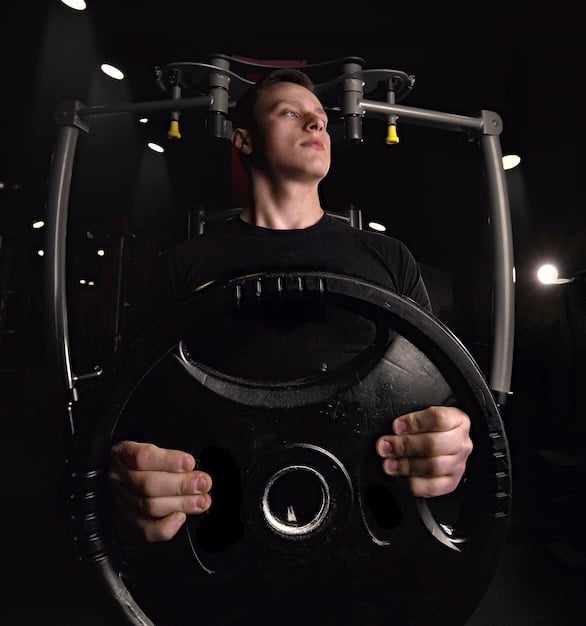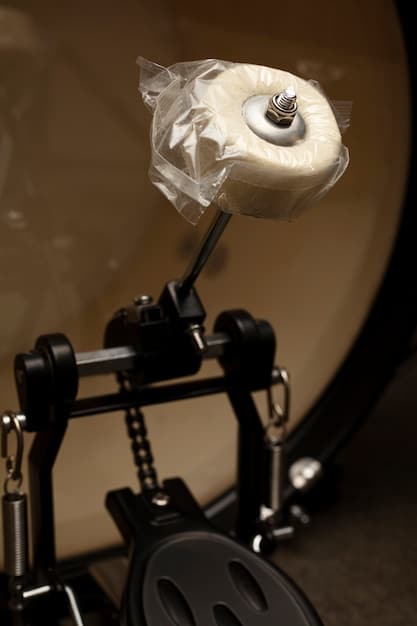Progressive Overload: The Science of Muscle Growth

Progressive overload is a fitness training principle that involves gradually increasing the stress placed on the body during exercise to stimulate muscle growth, strength gains, and improved performance.
Want to get stronger, build muscle, and see real results from your workouts? The secret lies in understanding and applying the science of progressive overload. This fundamental fitness principle is how you continuously challenge your body to adapt and improve.
Understanding Progressive Overload
At its core, progressive overload simply means consistently increasing the demands you place on your muscles over time. This forces your body to adapt by getting stronger and building more muscle mass. Without it, your progress will inevitably stall.
Imagine lifting the same weight for the same number of reps week after week. Your muscles will quickly adapt to this level of stress, and you’ll no longer be challenging them enough to stimulate growth. Progressive overload is the key to breaking through these plateaus and achieving your fitness goals.
Why Progressive Overload Matters
Progressive overload is not just a random workout strategy; it’s a scientifically backed method for achieving continuous improvement. Understanding why it works can help you implement it more effectively in your training regimen.
- Stimulates Muscle Growth: By consistently increasing the demands on your muscles, you create micro-tears that the body repairs and rebuilds, leading to hypertrophy (muscle growth).
- Enhances Strength: As your muscles adapt to heavier loads, their ability to generate force increases, resulting in improved strength.
- Prevents Plateaus: Without progressive overload, your body adapts to the current level of stress, and progress stagnates. It keeps your muscles challenged and prevents plateaus.
- Improves Performance: Progressive overload enhances overall athletic performance by improving various fitness components, such as strength, power, and endurance.
In summary, progressive overload is the cornerstone of effective training, ensuring that your muscles are continually challenged to adapt, grow, and become stronger over time.
Methods of Implementing Progressive Overload
There are several ways to implement progressive overload, and the best approach will depend on your individual goals, experience level, and training style. The key is to find methods that work for you and consistently apply them to your workouts.
Let’s explore some of the most common and effective strategies for gradually increasing the stress on your muscles.

Increasing Weight
This is the most straightforward and widely used method. Simply increase the amount of weight you lift for each exercise.
Start with small, manageable increments to avoid injury and ensure you can maintain proper form. For example, add 2.5 to 5 pounds to barbell exercises or use slightly heavier dumbbells.
Increasing Repetitions
If you’re not quite ready to increase the weight, try increasing the number of repetitions you perform with the same weight.
Aim to add one or two reps to each set until you reach the upper end of your target rep range. Once you can comfortably perform the maximum number of reps, it’s time to increase the weight.
Increasing Sets
Adding more sets to your workouts can also increase the overall volume and intensity, leading to greater muscle fatigue and growth.
Start by adding one set to each exercise and gradually increase the number of sets over time. Make sure to maintain proper form and allow for adequate rest between sets.
Decreasing Rest Time
Reducing the amount of rest you take between sets can increase the metabolic stress on your muscles, which can also contribute to muscle growth.
Gradually decrease your rest time by 15-30 seconds per set. This method can also improve your cardiovascular fitness and endurance.
Increasing Exercise Difficulty
You can also progressively overload by choosing more challenging variations of the same exercise. For example, progress from push-ups on your knees to full push-ups, or from bodyweight squats to weighted squats.
- Bodyweight Exercises: Progress from easier variations to more difficult ones (e.g., incline push-ups to decline push-ups).
- Resistance Training: Switch to more complex exercises that engage more muscle groups (e.g., machine press to barbell press).
- Flexibility and Mobility: Increase the range of motion in your exercises over time.
Experiment with different methods of progressive overload to find what works best for you. Combining these strategies can lead to even greater results.
Tracking Your Progress
To effectively implement progressive overload, it’s crucial to track your progress and monitor your performance. This will help you identify when it’s time to increase the intensity and ensure you’re consistently moving forward.
Keeping a detailed record of your workouts can also provide valuable insights into your training patterns and help you identify areas for improvement.
Workout Logs
A workout log is a simple yet powerful tool for tracking your progress. Record the exercises you perform, the weight you lift, the number of reps and sets you complete, and the rest time you take between sets.
You can use a physical notebook, a spreadsheet, or a fitness app to track your workouts. Choose a method that you find convenient and easy to use.
Measuring Body Composition
While tracking your lifts is important, it’s also helpful to monitor changes in your body composition, such as muscle mass and body fat percentage.
You can use methods such as:
- Bodyweight Scales: Track your overall weight to see if you are meeting your goals.
- Tape Measures: Measure circumference of arms, legs, chest to asses if muscles are growing

Taking Photos
Taking regular photos of your body can provide a visual record of your progress. This can be particularly motivating when you’re not seeing changes in the numbers.
Take photos in the same lighting and poses each time to ensure consistent comparisons. Focus on different angles to get a complete picture of your physique.
By consistently tracking your progress, you’ll be better equipped to make informed decisions about your training and optimize your results.
Avoiding Overtraining and Injury
While progressive overload is essential for progress, it’s important to implement it gradually and avoid pushing yourself too hard, too soon. Overtraining can lead to fatigue, injury, and burnout.
Listen to your body and pay attention to any signs of overtraining, such as persistent muscle soreness, decreased performance, and increased fatigue.
Proper Form
Maintaining proper form is crucial for preventing injuries, especially when lifting heavier weights. Focus on mastering the correct technique for each exercise before increasing the load.
If you’re unsure about your form, consider working with a qualified personal trainer who can provide feedback and guidance.
Rest and Recovery
Adequate rest and recovery are just as important as the training itself. Your muscles need time to repair and rebuild after each workout.
Make sure to get at least 7-8 hours of sleep per night and allow for rest days between workouts. Consider incorporating active recovery activities, such as stretching, yoga, or light cardio, to promote circulation and reduce muscle soreness.
Nutrition
Proper nutrition is essential for fueling your workouts and supporting muscle recovery. Consume a balanced diet that includes plenty of protein, carbohydrates, and healthy fats.
- Protein: Essential for muscle repair and growth. Aim for at least 0.8 grams of protein per pound of body weight per day.
- Carbohydrates: Provide energy for your workouts. Choose complex carbs, such as whole grains, fruits, and vegetables.
- Healthy Fats: Support hormone production and overall health. Include sources like avocados, nuts, and olive oil in your diet.
By prioritizing proper form, rest, and nutrition, you can minimize your risk of injury and maximize your results from progressive overload.
Progressive Overload for Different Fitness Goals
The principles of progressive overload can be applied to various fitness goals, whether you’re looking to build muscle, increase strength, improve endurance, or enhance overall athleticism.
However, the specific strategies you use may need to be adjusted depending on your individual objectives.
Muscle Hypertrophy
For muscle hypertrophy (growth), focus on moderate rep ranges (6-12 reps) with moderate to heavy weight. Emphasize time under tension and muscle fatigue.
Prioritize exercises that target multiple muscle groups and allow for a full range of motion.
Strength Gains
To increase strength, focus on low rep ranges (1-5 reps) with heavy weight. Emphasize maximal force production and power output.
Prioritize compound exercises, such as squats, deadlifts, bench press, and overhead press. Allow for longer rest periods between sets to ensure full recovery.
Endurance Training
For endurance training, focus on high rep ranges (15+ reps) with light to moderate weight. Emphasize cardiovascular fitness and muscular endurance.
Incorporate exercises that mimic the movements of your chosen sport or activity. Consider using methods such as circuit training and interval training to increase the intensity.
Athletic Performance
To enhance athletic performance, combine elements of strength, power, and endurance training. Focus on exercises that mimic the movements of your chosen sport and improve your overall athleticism.
- Plyometrics: Explode movements used to enhance speed.
- Agility Drills: Agility is key to quick changes of direction.
- Sport-Specific Training: It is important to train movements that reflect your sport
By tailoring your progressive overload strategies to your specific fitness goals, you can optimize your results and achieve your desired outcomes.
Sample Progressive Overload Program
To help you get started, here’s a sample progressive overload program that can be adapted to your individual fitness level and goals. This program focuses on compound exercises and incorporates various methods of progressive overload.
Remember to warm up before each workout and cool down afterwards. Listen to your body and adjust the program as needed.
Workout Schedule
Perform the following workouts 2-3 times per week, with at least one rest day between each workout.
Workout A:
- Squats: 3 sets of 8-12 reps
- Bench Press: 3 sets of 8-12 reps
- Bent-Over Rows: 3 sets of 8-12 reps
Workout B:
- Deadlifts: 1 set of 5 reps
- Overhead Press: 3 sets of 8-12 reps
- Pull-Ups: 3 sets to failure
Progressive Overload Strategies
Each week, choose one or two exercises to focus on for progressive overload. Use one or more of the following strategies:
- Increase the weight by 2.5-5 pounds.
- Add one or two reps to each set.
- Add one set to the exercise.
- Decrease the rest time between sets by 15-30 seconds.
Record your progress in a workout log and monitor your performance. Adjust the program as needed to ensure you’re consistently challenging your muscles and moving forward.
By following this sample progressive overload program, you can start seeing real results from your workouts and achieve your fitness goals.
| Key Point | Brief Description |
|---|---|
| 🏋️ Increase Weight | Lift heavier weights gradually over time. |
| 💪 Increase Reps | Add more repetitions per set as you get stronger. |
| ⏱️ Decrease Rest | Reduce rest time between sets to increase intensity. |
| 🔄 Change Exercises | Vary exercises to challenge muscles in new ways. |
Frequently Asked Questions
▼
Progressive overload is the gradual increase of stress placed upon the body during exercise. This principle ensures continuous improvements in muscle strength, size, and endurance by challenging muscles consistently.
▼
Increase weight or reps when you can comfortably perform the current workload with proper form. A good guideline is to aim for an increase each week, but listen to your body.
▼
Yes, progressive overload can be applied to cardio. Increase the duration, intensity (speed or resistance), or incline of your workouts to continuously challenge your cardiovascular system and improve endurance.
▼
If you can’t increase weight, focus on increasing reps, sets, or decreasing rest time. Small increments over time still contribute to progressive overload, even if they aren’t always weight-related.
▼
Yes, progressive overload is suitable for beginners. Start with lighter weights and focus on mastering proper form. Gradually increase the weight or reps as you get stronger to achieve continuous improvements.
Conclusion
Incorporating the principles of progressive overload into your fitness routine is the surest path to seeing continuous gains in strength, muscle growth, and overall performance. Remember to listen to your body, track your progress, and make gradual adjustments to your training to avoid overtraining and maximize your results. Now that you understand the science of progressive overload, you’re well-equipped to take your fitness to the next level.





